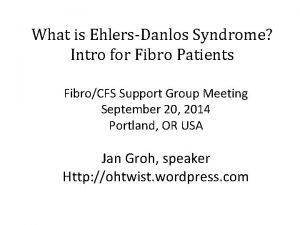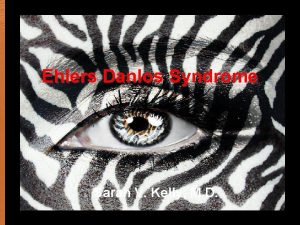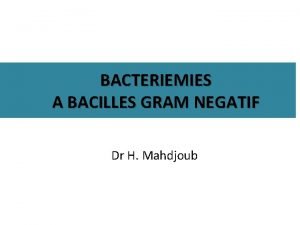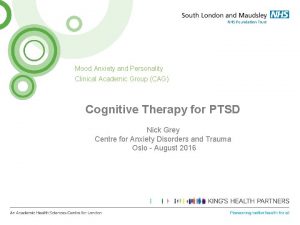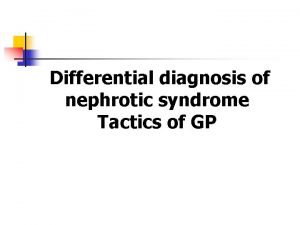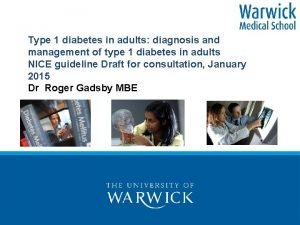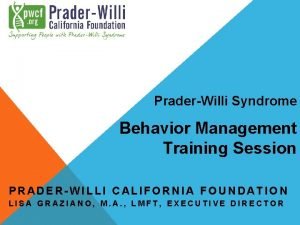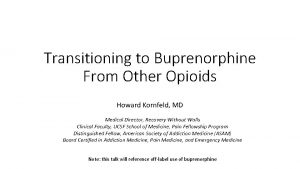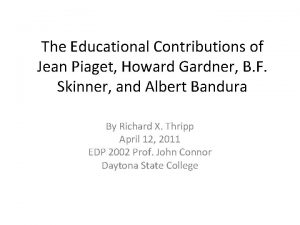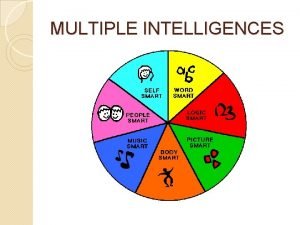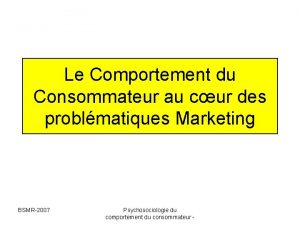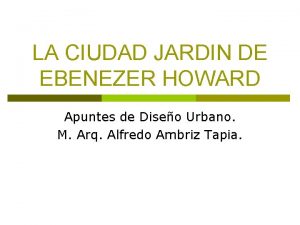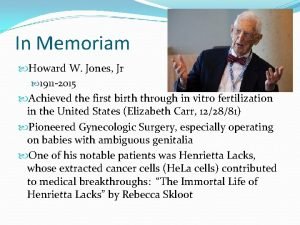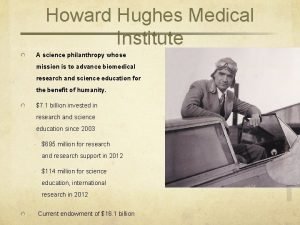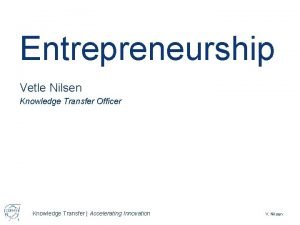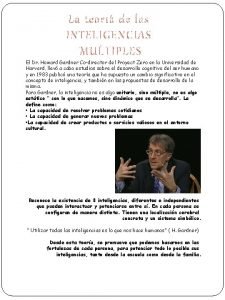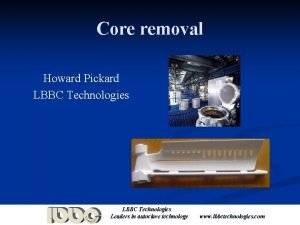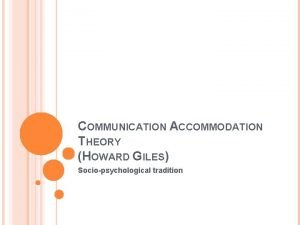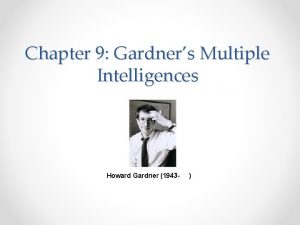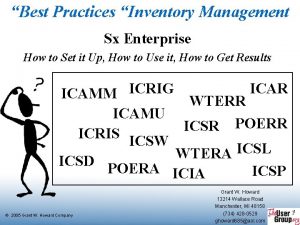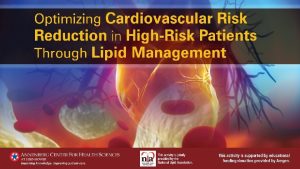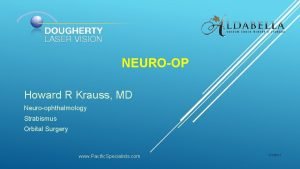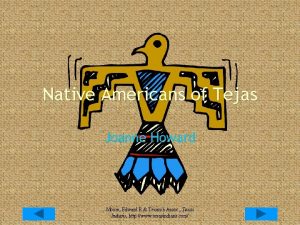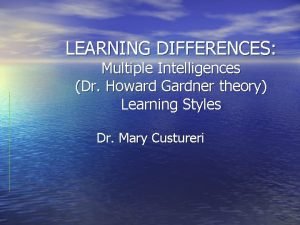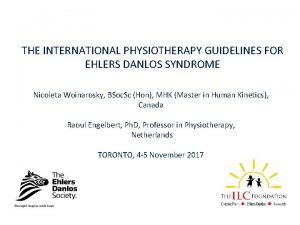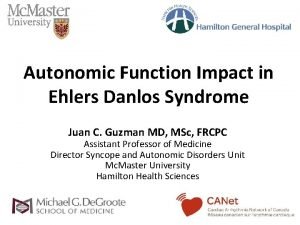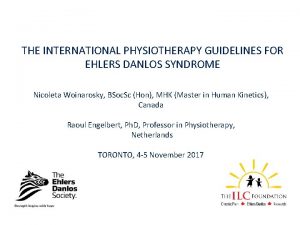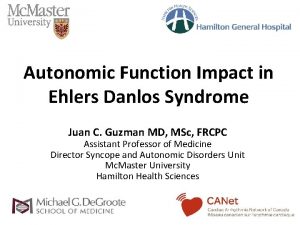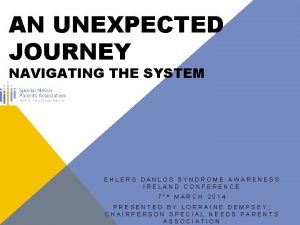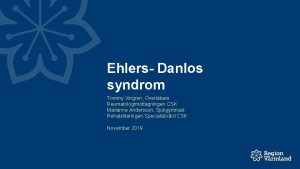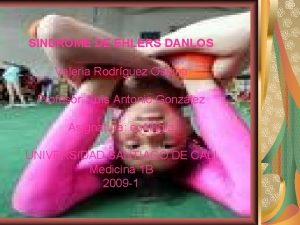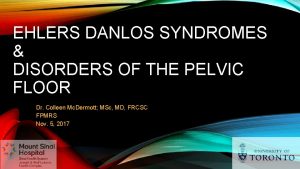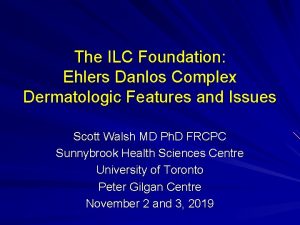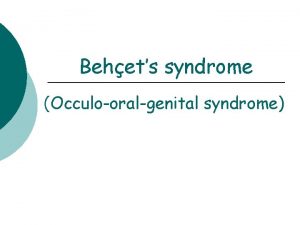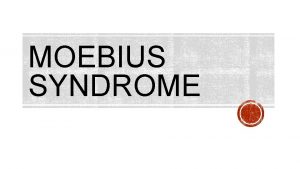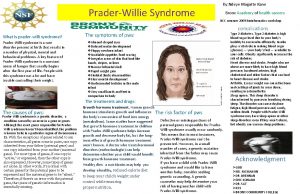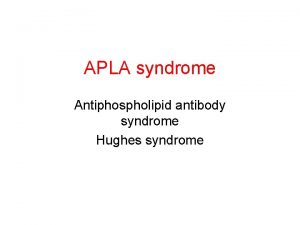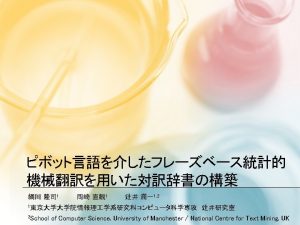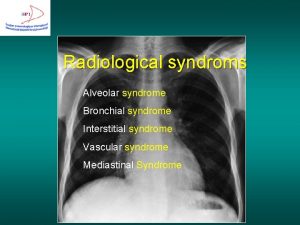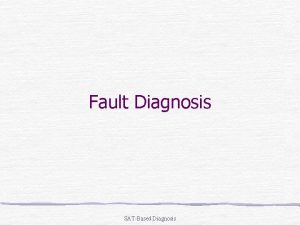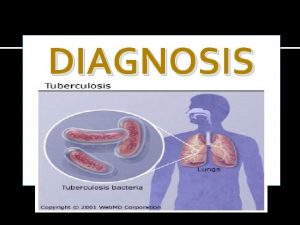Ehlers Danlos Syndrome Recognition Diagnosis Management Howard P
























































- Slides: 56

Ehlers Danlos Syndrome: Recognition, Diagnosis & Management Howard P. Levy, M. D. , Ph. D. Assistant Professor, Johns Hopkins University Johns Hopkins Adolescent Medicine Grand Rounds Baltimore, MD October 12, 2012

Disclosures 1. No relevant financial relationships 2. I will discuss non-FDA labeled use of the following medications: § Tricyclic antidepressants for neuropathic pain § SNRI antidepressants for neuropathic pain § Anti-seizure medications for neuropathic pain

Learning Objectives • Recognize features of EDS • Initiate appropriate evaluation • Understand activity and other management recommendations

Case 1: 18 yo Girl With Knee Pain & Instability • 5 -6 yrs bilat knee pain & patellar instability • Failed: § steroid & Synvisc injections § debridement, chondroplasties, plication, synovectomy, lateral release, osteotomies, ligament reconstruction (11 total procedures) § aquatic resistance exercise • Gave up lacrosse, soccer, horse riding • Easy bruising, no other skin sx’s

Case 1: Exam • Palate: normal • Tender paralumbar spasm • Laxity in all joints § Pes planus § Beighton score 8/9 • Skin normal

Case 2: 32 yo Man With Left Shoulder Pain • Acute onset weightlifting 1 year prior • Improves w/rest; recurs w/weightlifting • Also pain in forearms & knees • No subluxations/dislocations • Failed resistance bands & light weights • Easy bruising, prolonged bleeding • Fatigue on/off x 15 years

Case 2: Exam • Palate: high, narrow, intact • Tender left trapezius spasm • Laxity § Shoulders, elbows, wrists, fingers § Left knee only (muscular, especially LE) § Pes planus § Beighton score 8/9 • Skin normal

Case 3: 15 yo Girl With Shoulder Pain & Instability • 10 months of § pain w/push ups § subluxation w/swimming • Hip subluxation (spont vs. traumatic? ) • Gave up volleyball • Continues to tolerate swimming, cross -country, and track

Case 3: Exam • Palate: normal • Tender paralumbar spasm • Laxity § moderate in shoulders; mild in wrists/fingers § none elsewhere § Beighton score 2/9 (thumbs only) • Skin normal

Diagnoses • Case 1: Ehlers Danlos Hypermobility Type • Case 2: Ehlers Danlos Hypermobility Type • Case 3: Isolated shoulder pain/instability

Ehlers Danlos Syndrome • • • HYPERMOBILITY TYPE (III) Joint laxity Pain (arthralgia, myalgia, headache) Fatigue Worse with resistance & activity High narrow palate/dental crowding Easy bruising, mildly soft skin

Ehlers Danlos Syndromes • Heritable disorders of connective tissue • Collagen • Prevalence 1: 5000? (probably more common)

Ehlers Danlos Syndromes • Joint laxity • High narrow • Soft skin palate • Gastritis & IBS • POTS & NMH • Easy bruisability

EDS Types

EDS: Revised Nosology Beighton et al, Am J Med Genet (1998) 77: 31 -37 TYPE OLD # Hypermobility III Classical I & II Vascular IV Arthrochalasia VIIA & B Kyphoscoliosis VI Dermatosparaxis VIIC PATTERN Autosomal Dominant Autosomal Recessive

EDS: Hypermobility (III) • “Benign Joint Hypermobility Syndrome” 1 • Joint laxity • Soft skin • Easy bruisability • Least severe, BUT pain disability • Autosomal dominant • Genetic cause unknown 1. Tinkle et al. Am J Med Genet A. 2009; 149 A: 2368– 70

Assessing Joint Laxity • • • Subjective ROM Hyperextension Lateral instability A/P instability Varus/valgus Telescoping • • Objective Beighton Scale 1 9 possible points “+” = 5 or more Doesn’t assess all joints Not “Gold Std” 1. Beighton et al. Ann Rheum Dis. 1973; 32: 413– 8

Beighton Scale Palms to floor, knees straight: 1 point

Beighton Scale o Hyperextend elbow >10 : 1 point each Radial Styloid Lateral Humeral Epicondyle Humeral Head

Beighton Scale o Hyperextend knee >10 : 1 point each Greater Trochanter Lateral Femoral Condyle Lateral Malleolus

Beighton Scale o Dorsiflex 5 th finger >90 : 1 point each Appose thumb to forearm: 1 point each

Assessing Joint Laxity Caveats • Age § Young children: loose § Older adults: stiff • Sex: Female looser than male • Trauma/DJD/Surgery • Muscle tone or bulk • Guarding

EDS: Classical (I & II) • All features of Hypermobility Type • More severe skin and soft tissue • Autosomal Dominant • Type 5 collagen in 50% of pts § 90 -95% w/stricter clinical criteria 1 • Clinical DNA test available § clinical utility? 1. Symoens et al. Hum Mutat. 2012; 33: 1485– 1493

EDS: Classical - Skin • Very soft, sometimes doughy • Hyperelasticity § Avoid loose skin § Volar wrist— normal ~1 cm

EDS: Classical - Skin • Very soft, sometimes doughy • Hyperelasticity • Skin fragility § Extensor surfaces

EDS: Classical - Skin • Molluscoid pseudotumor § Thickened § Hyperpigmented § Elbows § Knees Atrophic Scars

EDS: Classical – Soft Tissue • Wound dehiscence • Soft tissue fragility (“wet toilet paper”) • Ligaments & Tendons • Rarely vascular tears

EDS: Vascular (IV) • Joint laxity § Small >> large § Wrists, fingers, ankles, toes

EDS: Vascular (IV) • Joint laxity • Fragile skin • Thin translucent skin

EDS: Vascular (IV) • Wound dehiscence • Dissection/rupture § Arteries § Intestine § Uterus § Tendons • Some never dissect/rupture § 80% of 1 st events ages 10 -39

EDS: Vascular (IV) • Autosomal Dominant • Type 3 Collagen (100% of pts. ) § Skin, vessels, hollow organs • Clinical DNA sequencing • Biochemical assay from skin fibroblasts also available

Differential Dx: Joint Laxity WWW. OMIM. ORG

Differential Dx: Joint Laxity Dozens other than EDS • Marfan • Loeys-Dietz • Stickler • Fragile X • Turner

Diagnostic Work-up • Joint & skin exam • Echo (diff dx & clinical mgmt) § Aortic root dilation (up to 1/3 patients) § Other abnormalities • Ophtho if suspect Marfan or Stickler • Genetics consultation

Management

What We Know • Laxity & instability • Pain—out of proportion to exam/x-rays • Fatigue • Osteoarthritis (DJD)

What We Don’t Know Why?

Working Hypothesis Laxity Frequent minor subluxations Reflexive muscle spasm Pain Osteoarthritis Fatigue

Working Hypothesis Laxity Frequent minor subluxations Reflexive muscle spasm Pain Osteoarthritis Fatigue

Joint Instability MUSCLE TONING Strength: A source of power or force Tone: The normal state of elastic tension or partial contraction in resting muscles Increased strength can sublux the joints Increased tone can improve joint stability

“Resistance is Useless” -Vogon guard, The Hitchhiker's Guide to the Galaxy, Douglas Adams Avoid (minimize) • Hyperextension • Impact • Resistance Caution With • Elastic bands • Isometrics • Weights

Toning Exercise • Low or non-resistance exercise § Walking, Elliptical, Bicycle § Swimming/Aquatherapy § ROM • Add repetitions, duration & frequency • Start low, go slow • Long horizon § Months to stop getting worse § Years to start getting better

Joint Instability • External bracing when needed • Joint stabilizing surgery? § Increased rate of immediate & shortterm failure 1, 2 § Soft tissue fragility & wound dehiscence in Classical & Vascular EDS 1. Rombaut et al. Arch Phys Med Rehabil. 2011; 92: 1106– 12 2. Rose et al. J Arthroplasty. 2004; 19: 190– 6

Working Hypothesis Laxity Frequent minor subluxations Reflexive muscle spasm Pain Osteoarthritis Fatigue

Muscle Spasm • Myofascial release § Heat, massage, TENS, acupuncture… § Hours-days of relief • Special mattress § Water, air, viscoelastic foam • Medications § Skeletal muscle relaxers § Benzodiazepines (caution)

Working Hypothesis Laxity Frequent minor subluxations Reflexive muscle spasm Pain Osteoarthritis Fatigue

Pain: Etiology? • Myofascial spasm? § aching, throbbing, tight… • Neuropathic? § burning, tingling, electric… • DJD? § dull, aching, throbbing…

Pain: Passive & Mechanical Therapy • Myofascial release: ice, heat, massage, acupuncture/pressure, u/s, TENS… • Nerve blocks, joint/bursa injections § Limited benefit; can’t repeat indefinitely • Implantable stimulators • Other? (individualized therapy)

Pain: Medication • Analgesics & Anti-inflammatories § Acetaminophen, NSAIDs, Tramadol • Transdermal lidocaine • Muscle Relaxers • Neuropathic pain control § Tricyclics, SNRIs, Anti-seizure • Opioids—last resort

Pain: Medication • Cocktail of multiple medications • Scheduled, preventive medication more effective than as-needed • Goal is to limit, but not eliminate pain • Pain management specialists

Pain: Psychology “ 90% of the game is half mental” -Yogi Berra • The underlying problems are real • But pain is a subjective experience • Emotional State • Goals and expectations • Fears • Avoidance, disability, isolation • others…

Emotional State Common in EDS: • Anxiety & Depression • Low self-confidence • Negative thinking • Hopeless/helpless • Desperation • Low self-efficacy Baeza-Velasco et al (2011) Rheumatol Int. 31: 1131; Branson et al (2011) Harv Rev Psychiatry 19: 259; Castori et al(2010) Am J Med Genet A. 152 A: 556; Hagberg et al (2004) Orthod Craniofac Res. 7: 178; Rombaut et al (2011) Arthritis Rheum. 63: 1979

Expectation Management High Bar • No pain • No dislocations or subluxations • “Normal” activity tolerance Low Bar • Less pain • Fewer dislocation or subluxations • Improved activity tolerance

Pain: Psychological Tx • Relationships with healthcare providers. § Clinician must validate symptoms as real § Patient must trust that psych components play a role • Counseling § Depression, anxiety… § Accepting & coping w/pain & dysfunction • Cognitive Behavioral Therapy, conscious relaxation, hypnosis, meditation…

Resources • www. genereviews. org § clinically oriented reviews • www. omim. org § encyclopedic genetic catalog • www. ednf. org § patient support group

Additional References & Information Levy, Gene. Reviews, 2012 http: //www. ncbi. nlm. nih. gov/books/NBK 1279/#eds 3
 The ross sisters ehlers-danlos syndrome
The ross sisters ehlers-danlos syndrome Eds
Eds Ecthyma gangreneux d'ehlers
Ecthyma gangreneux d'ehlers Mesa and trading market cycles pdf
Mesa and trading market cycles pdf Ptsd model ehlers and clark
Ptsd model ehlers and clark Potential nursing diagnosis
Potential nursing diagnosis Medical diagnosis and nursing diagnosis difference
Medical diagnosis and nursing diagnosis difference Medical diagnosis and nursing diagnosis difference
Medical diagnosis and nursing diagnosis difference Nursing process objectives
Nursing process objectives Perbedaan diagnosis gizi dan diagnosis medis
Perbedaan diagnosis gizi dan diagnosis medis Nephrotic syndrome differential diagnosis
Nephrotic syndrome differential diagnosis Osteochondrosis
Osteochondrosis Carpal tunnel differential diagnosis
Carpal tunnel differential diagnosis Kara potter
Kara potter Waterhouse friderichsen syndrome diagnosis
Waterhouse friderichsen syndrome diagnosis Four i's of transformational leadership
Four i's of transformational leadership Type 1 diabetes in adults diagnosis and management
Type 1 diabetes in adults diagnosis and management Prader-willi syndrome behavior management
Prader-willi syndrome behavior management Nursing management of malabsorption syndrome
Nursing management of malabsorption syndrome Maryland young authors contest
Maryland young authors contest Howard kornfeld md
Howard kornfeld md Pavlov'un şartlandırılmış öğrenme modeli
Pavlov'un şartlandırılmış öğrenme modeli Ebenezer howard
Ebenezer howard How are howard gardner and jean piaget different?
How are howard gardner and jean piaget different? Howard ikemoto daughter
Howard ikemoto daughter Parc du domaine howard
Parc du domaine howard Howard gardner ap psychology
Howard gardner ap psychology Www. edutopia.org/multiple-intelligences-introduction
Www. edutopia.org/multiple-intelligences-introduction Nicosia 1966
Nicosia 1966 Ciudad jardín letchworth
Ciudad jardín letchworth Howard jones henrietta lacks
Howard jones henrietta lacks Howard university strategic plan
Howard university strategic plan Howard schultz leadership qualities
Howard schultz leadership qualities Is howard schultz a good leader
Is howard schultz a good leader Howard hughes philanthropy
Howard hughes philanthropy Howard county gifted and talented
Howard county gifted and talented Howard koenig
Howard koenig Howard h stevenson
Howard h stevenson Dr howard gardner
Dr howard gardner Lbbc technologies
Lbbc technologies Title
Title Accommodation theory howard giles
Accommodation theory howard giles Gardner's nine intelligences
Gardner's nine intelligences Gail howard
Gail howard Grant howard inventory
Grant howard inventory Building a life howard stevenson
Building a life howard stevenson Endovalve
Endovalve The king of all media
The king of all media Minnie howard high school
Minnie howard high school Howard shore lighthouse
Howard shore lighthouse Marion meanwell
Marion meanwell Howard shaw singapore
Howard shaw singapore Howard university
Howard university Peter howard jones
Peter howard jones Neuroop
Neuroop Joanne howard
Joanne howard Dr. howard gardner
Dr. howard gardner
